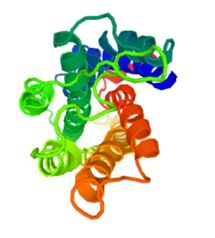Introduction of PTGER4
PTGER4, also known as Prostaglandin E2 receptor 4 or EP4, is a prostaglandin receptor for prostaglandin E2 (PGE2) encoded by the PTGER4 gene in humans. PTGER4 is able to bind prostaglandin E2 (PGE2) and mediates specific aspects of both inflammatory and regulatory eicosanoid signaling. In humans, mRNA for PTGER4 has been found by Northern blotting in the heart and small intestine and to lesser extents in lung, thymus, kidney, uterus, brain and dorsal root ganglions. Besides, PTGER4 protein is found in humans as measured via immunochemistry in pulmon.
| Basic Information of PTGER4 | |
| Protein Name | Prostaglandin E2 receptor EP4 subtype |
| Gene Name | PTGER4 |
| Aliases | Prostaglandin E2 receptor EP4 subtype, PGE receptor EP4 subtype, PGE2 receptor EP4 subtype, Prostanoid EP4 receptor |
| Organism | Homo sapiens (Human) |
| UniProt ID | P35408 |
| Transmembrane Times | 7 |
| Length (aa) | 488 |
| Sequence |
MSTPGVNSSASLSPDRLNSPVTIPAVMFIFGVVGNLVAIVVLCKSRKEQKETTFY TLVCGLAVTDLLGTLLVSPVTIATYMKGQWPGGQPLCEYSTFILLFFSLSGLSII CAMSVERYLAINHAYFYSHYVDKRLAGLTLFAVYASNVLFCALPNMGLGSSRLQY PDTWCFIDWTTNVTAHAAYSYMYAGFSSFLILATVLCNVLVCGALLRMHRQFMRR TSLGTEQHHAAAAASVASRGHPAASPALPRLSDFRRRRSFRRIAGAEIQMVILLI ATSLVVLICSIPLVVRVFVNQLYQPSLEREVSKNPDLQAIRIASVNPILDPWIYI LLRKTVLSKAIEKIKCLFCRIGGSRRERSGQHCSDSQRTSSAMSGHSRSFISREL KEISSTSQTLLPDLSLPDLSENGLGGRNLLPGVPGMGLAQEDTTSLRTLRISETS DSSQGQDSESVLLVDEAGGSGRAGPAPKGSSLQVTFPSETLNLSEKCI |
Function of PTGER4 Membrane Protein
On account of the ability of PTGER4, it is classified as a relaxant type of prostaglandin receptor, upon activation, to relax the contraction of certain smooth muscle preparations and smooth muscle-containing tissues that have been pre-contracted by stimulation. To date, PTGER4 plays a vital role in many biological functions. It has proven that activation of PTGER4 suppresses the production of IL-12p70 and increases IL-23, thereby promoting the development of IL-17-producing Th17 cells, a subset of pro-inflammatory T helper cells that serves to maintain mucosal barriers, clear mucosal surfaces of pathogens, and contribute to autoimmune and inflammatory disorders. In addition, PTGER4 appears to serve anti-inflammatory and protective functions in the colon, and agonists of this receptor may be useful for treating inflammatory bowel diseases such as ulcerative colitis.
 Fig.1 Structure of PTGER4 membrane protein.
Fig.1 Structure of PTGER4 membrane protein.
Application of PTGER4 Membrane Protein in Literature
The article provides a comprehensive overview of the current progress of the PGE2-EP4 signaling in ischemic heart diseases, including cardiac hypertrophy and myocardial ischemia/reperfusion injury.
The article reviews the structural features of EP modulators required for subtype-selective activity, as well as the structural requirements for improved pharmacokinetic parameters.
The article identifies a new metabolic dimension in the physiologic role played by endogenous EP4. Upon high-fat feeding, prostaglandin E receptor subtype 4 (EP4)-knockout mice gain less body weight than their EP4(+/+) littermates.
The article indicates that EP4 is involved in mechanisms for prostaglandin E(1) actions on the cochlea, and local EP4 agonist treatment could attenuate acute sensorineural hearing loss.
The article suggests that a novel series of para-N-acylaminomethylbenzoic acids were identified and developed as selective prostaglandin EP4 receptor antagonists.
PTGER4 Preparation Options
To obtain the soluble and functional target protein, the versatile Magic™ membrane protein production platform in Creative Biolabs enables many flexible options, from which you can always find a better match for your particular project. Aided by our versatile Magic™ anti-membrane protein antibody discovery platform, we also provide customized anti-PTGDR antibody development services.
As a forward-looking research institute as well as a leading customer service provider in the field of membrane protein, Creative Biolabs has won good reputation among our worldwide customers for successfully accomplishing numerous challenging projects including generation of many functional membrane proteins. Please feel free to contact us for more information.
All listed services and products are For Research Use Only. Do Not use in any diagnostic or therapeutic applications.